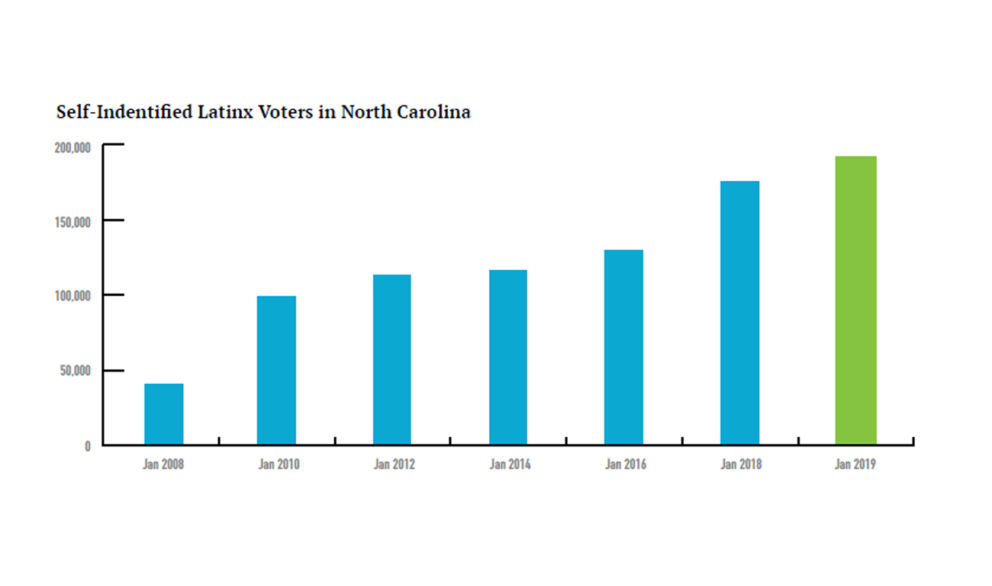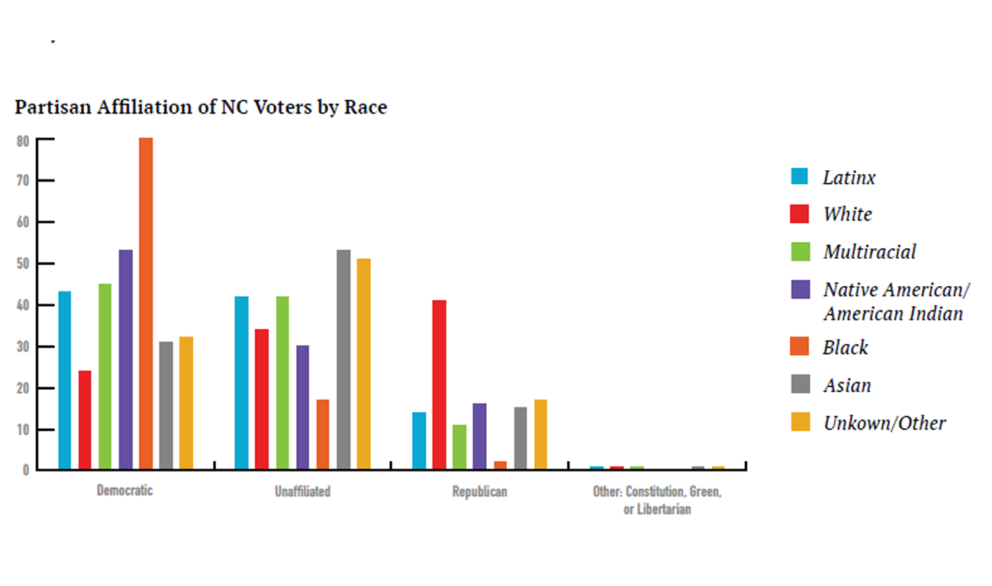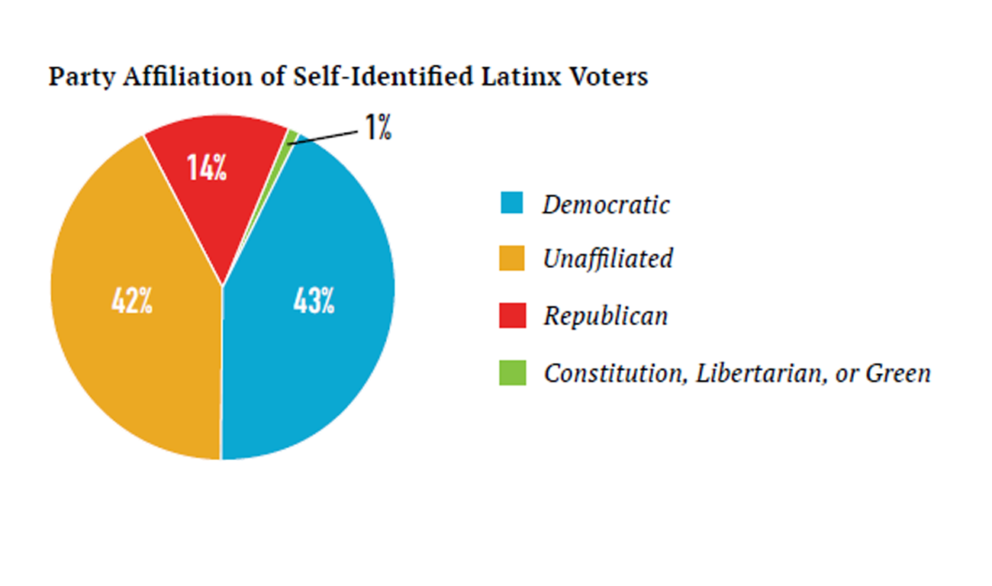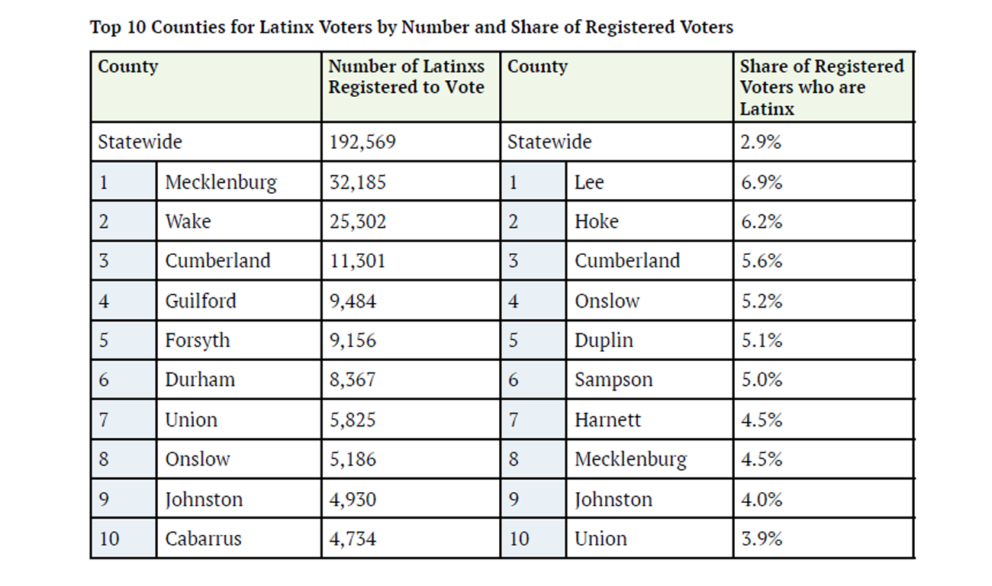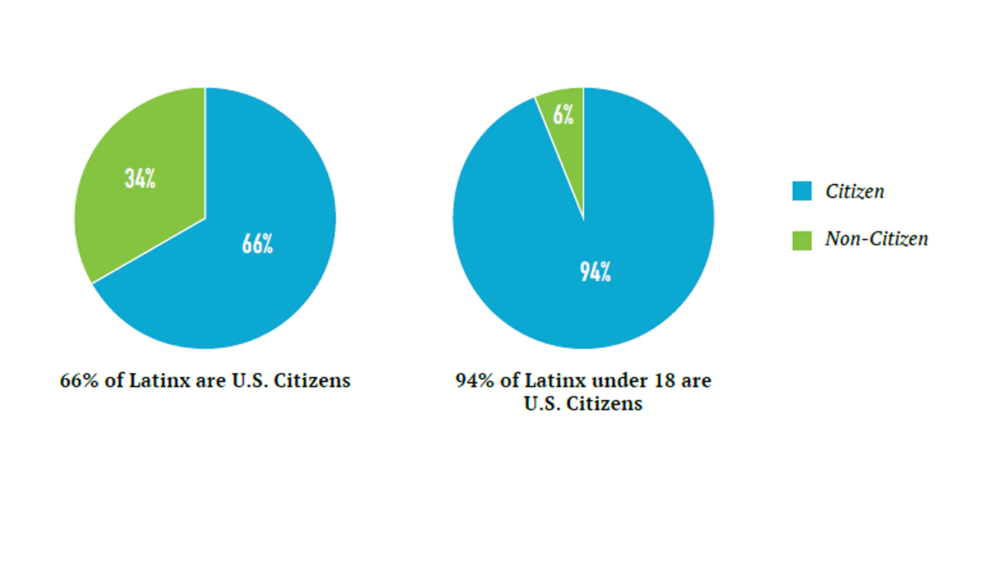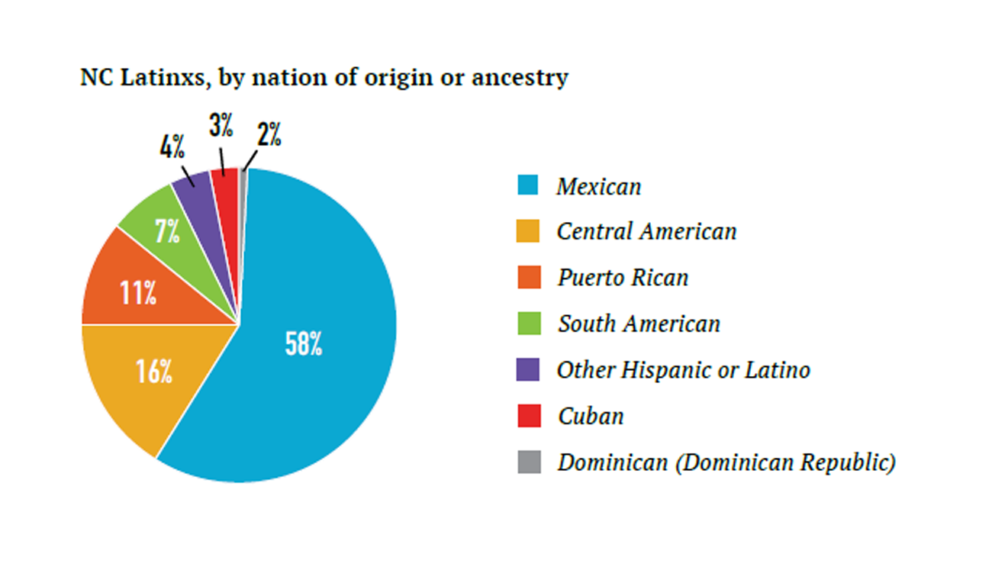End Notes
1 U.S. Census Bureau, Sex by Age (Hispanic or Latino), (2017), https://factfinder.census.gov/bkmk/table/1.0/en/
ACS/17_5YR/B01001I/0400000US37;
U.S. Census Bureau, Sex by Age, (2017), https://factfinder.census.gov/bkmk/table/1.0/en/ACS/17_5YR/
B01001/0400000US37;
U.S. Census Bureau, Sex by Age by Nativity and Citizenship Status (Hispanic or Latino), (2017), https://factfinder.cen-sus.gov/bkmk/table/1.0/en/ACS/17_5YR/B05003I/0400000US37
2 Isela Gutiérrez-Gunter and Bob Hall, A Snapshot of Latino Voters in North Carolina, Democracy North Carolina, (July 2012), https://democracync.org/wp-content/uploads/2017/07/snapshot-of-latino-voters-in-nc.pdf
3 Mark Hugo Lopez, Ana Gonzalez-Barrera, Jens Manuel Krogstad, More Latinos Have Serious Concerns About Their Place in America Under Trump, Pew Research Center Hispanic Trends, (Oct. 25, 2018), https://www.pewhispanic.
org/2018/10/25/more-latinos-have-serious-concerns-about-their-place-in-america-under-trump/
4 Jens Manuel Krogstad, Antonio Flores, Mark Hugo Lopez, Key takeaways about Latino voters in the 2018 midterm elections, Pew Research Center, (Nov. 9, 2018), https://www.pewresearch.org/fact-tank/2018/11/09/how-latinos-voted-in-2018-midterms/
5 Lulu Garcia-Navarro, Record Latino Turnout Was A Huge Factor In Democrats’ Midterm Election Wins, National Public Radio (Dec. 16, 2018, 8:03 AM), https://www.npr.org/2018/12/16/677157715/record-latino-turnout-was-a-huge-factor-in-democrats-midterm-election-wins
6 As noted in Democracy North Carolina’s 2012 “Snapshot of Latino Voters in North Carolina,” voter registration forms failed to include a “Hispanic or Latino” option until 2002. As a result, it is likely there are many more Latinx voters who may not be represented in the data below, including voters who have not updated their voter registration since 2002, voters who skipped the question on ethnic identity on their voter registration form, or voters who are listed at “Other” or “Unknown” in the voter registration database. The analysis below is based on voters who are designated “Hispanic or Latino” in North Carolina’s voter data.
7 Analysis by Democracy NC, data retrieved from North Carolina State Board of Elections, “voter_stats_20181106” and “history_stats_20181106,” (November 6th, 2018), https://dl.ncsbe.gov/?prefix=ENRS/2018_11_06/
8 Alamance, Buncombe, Chatham, Dare, Durham, Granville, Haywood, Jackson, Madison, Mitchell, Orange, Union, Wake, Watauga, Yancey
9 Analysis by Democracy NC, data retrieved from North Carolina State Board of Elections, Registration Numbers and Analysis, “ncvoter_statewide,” as of June 8th, 2019, https://dl.ncsbe.gov/?prefix=data/ and from North Carolina State Board of Elections, Voter Registration Statistics, https://vt.ncsbe.gov/RegStat/.
10 https://www.catalist.us/
11 Additional information about this estimate available upon request. As pointed out by NALEO researchers, who use Catalist data,“analysts identify Latino registered voters in the files through the use of independent software appli-cations that generally utilize Spanish surnames and other demographic analysis to identify Latino registered voters. However, some individuals with Spanish surnames are not Latino, and some Latinos do not have Spanish surnames. Thus, Spanish surname software applications are subject to error because they do not capture a precise count of Latino registered voters, rather only those registered voters who possess a Spanish surname.” http://s143989.gridserver.com/downloads/2016/NALEO2016_PresidentialElections_6-20-16-FP.pdf
12 Analysis by Democracy NC, data retrieved from North Carolina State Board of Elections, Registration Numbers and Analysis, “ncvoter_statewide,” as of June 8, 2019, https://dl.ncsbe.gov/?prefix=data/;
North Carolina State Board of Elections, Historical Registration Numbers, as of June 8, 2019. https://vt.ncsbe.gov/Reg-Stat/.
13 Analysis by Democracy NC, data retrieved from North Carolina State Board of Elections,“ncvoter_statewide,” as of June 8th, 2019. https://dl.ncsbe.gov/?prefix=data/
14 National Association of Latino Elected and Appointed Officials (NALEO), NALEO 2016 Latino Election Handbook,
(June 20, 2016), http://s143989.gridserver.com/downloads/2016/NALEO2016_PresidentialElections_6-20-16-FP.pdf
15 Duplin, Lee, Sampson, Greene, Montgomery, Durham, Forsyth, Johnston, Hoke, Mecklenburg, Chatham, Wayne https://www.osbm.nc.gov/demog/county-projections
16 US Census Bureau, Hispanic or Latino Origin by Specific Origin, (2017), https://factfinder.census.gov/bkmk/table/1.0/en/ACS/17_5YR/B03001/0400000US37,
US Census Bureau, Sex by Age and Nativity and Citizenship Status, (2017), https://factfinder.census.gov/bkmk/ta-ble/1.0/en/ACS/17_5YR/B05003I/0400000US37
17 Analysis by Democracy NC, data retrieved from North Carolina State Board of Elections, “history_stats_20161108,”
(Nov 8th, 2016). https://dl.ncsbe.gov/?prefix=ENRS/2016_11_08/.
18 Allow Early Voting/Last Saturday/Flexibility. House Bill 893. Available at https://www.ncleg.gov/Sessions/2019/Bills/House/PDF/H893v1.pdf.
19 Alexandra Forter Sirota, Luis Toleda, William Munn, and Patrick McHugh, The Cost of Creating Barriers to Vote, Bud-get and Tax Center (BTC) Report, (Sept 2018), https://democracync.org/wp-content/uploads/2018/09/BTC-REPORT-photo-ID-2018.pdf
20 Department of Commerce v. New York, No. 18-966, 2019 WL 2619473 (U.S. June 27, 2019).
Press Release, Democracy North Carolina, Democracy NC Responds to SCOTUS Ruling on Census Citizenship Question, (Jun. 27, 2019), https://democracync.org/news/democracy-nc-responds-to-scotus-ruling-on-census-citizenship-ques-tion/



